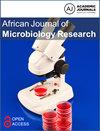Molecular characterization of high-risk infection vaginal bacteria isolated from pregnant women in CHU-MEL of Cotonou (Benin)
引用次数: 0
Abstract
The aim of this study is to determine the distribution of the genotypic pathogenicity traits of vaginal high-risk infectious bacteria (HRIB) collected in the CHU-MEL of Cotonou (Benin). To achieve this, a recto-vaginal swab of 42 pregnant women in the third trimester of pregnancy was collected. Species identification was carried out by specific biochemical tests. Antimicrobial susceptibility was tested according to the microbiology standard recommendation. Macrolide resistance genes in Gram-positive bacteria and virulence genes in Escherichia coli were investigated by polymerase chain reaction (PCR). E. coli is the most isolated species (14.7%) followed by Klebsiella pneumoniae (11.8%). Mono-microbial carriage was 55.9%. Gram-negative antibiotic susceptibility shows strong resistance to beta lactam. While Gram-positive bacteria showed strong resistance to beta-lactamine, tetracycline and macrolides with cMLS B (70.4%), iMLS B (3.7%) and M (25.9%) phenotypes. ErmB and ermTR were not detected in Gram-positive bacteria but mef(A/E) was detected at a high. Virulence genes in E. coli were detected and fimA was the most common (52.2%) followed by sfa/foc (30.4%) and cnf1 (13.0%). NeuC and ibeA have not been detected. The hvgA virulence gene was detected in S. agalactiae at a rate of 61.54%. These results demonstrate the importance of introducing antenatal screening for HRIB to improve obstetric and neonatal management in Benin.从科托努(贝宁)CHU-MEL孕妇身上分离的高危感染阴道细菌的分子特征
本研究的目的是确定在科托努(贝宁)的CHU-MEL中收集的阴道高危感染菌(HRIB)的基因型致病性特征的分布。为此,收集了42名妊娠晚期孕妇的直肠阴道拭子。物种鉴定是通过特定的生化测试进行的。根据微生物学标准的建议对抗菌药物的敏感性进行了测试。采用聚合酶链式反应(PCR)方法对革兰氏阳性菌大环内酯类耐药基因和大肠杆菌毒力基因进行了研究。大肠杆菌是分离最多的菌种(14.7%),其次是肺炎克雷伯菌(11.8%)。单菌携带率为55.9%。革兰氏阴性抗生素敏感性显示对β-内酰胺有很强的耐药性。而革兰氏阳性菌对β-内酰胺、四环素和大环内酯类药物表现出较强的耐药性,具有cMLS B(70.4%)、iMLS B和M(25.9%)表型。ErmB和ermTR在革兰氏阳性菌中未检测到,但mef(A/E)检测到较高。在大肠杆菌中检测到毒力基因,其中fimA最常见(52.2%),其次是sfa/foc(30.4%)和cnf1(13.0%),未检测到NeuC和ibeA。在无乳双歧杆菌中检测到hvgA毒力基因的比率为61.54%。这些结果表明,引入HRIB产前筛查对改善贝宁产科和新生儿管理的重要性。
本文章由计算机程序翻译,如有差异,请以英文原文为准。
求助全文
约1分钟内获得全文
求助全文

 求助内容:
求助内容: 应助结果提醒方式:
应助结果提醒方式:


